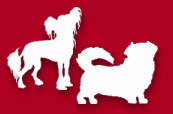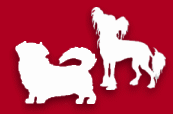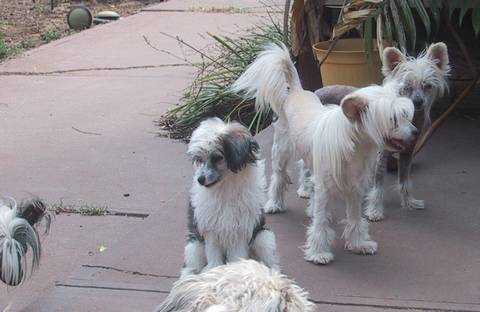|
|
|
Nature's Chinese Puzzle
The Chinese Crested - Nature's "Chinese Puzzle" by Nancy Larson
There is a fascinating member of the Toy Group known as the Chinese Crested, a "toy" dog that has two varieties. A hairless variety that includes hair on the head, tail and feet, and a puff, a fully coated counterpart with a long double coat. However, within each of these two varieties, we have some rather dramatic variations.
The Hairless: "The Hairless variety has hair on certain portions of the body:
the head (called a crest), the tail (called a plume) and the feet,
from the toes to the front pasterns and rear hock joints (called socks).
The texture of all hair is soft and silky, flowing to any length.
Placement of hair is not as important as overall type. Areas that
have hair usually taper off slightly. Wherever the body is hairless,
the skin is soft and smooth."
This "ideal" is what breeders aspire to achieve within their breeding programs, although it is not as easy as it might first appear.The gene that causes the hairlessness is dominant, however, it's an INCOMPLETE dominant. This means that you can get some interesting and even extreme variations in the amount of hair an individual dog can have. Hairless cresteds can be seen with everything from absolutely no hair anywhere, to ones that are basicallyfully coated with a single coat, and everything in between. There is no "magic formula" for breeders to use to producedogs with the hair only "where it should be". You can breed two hairless cresteds together, that have absolutely no hair and get puppies that not only have hair where you want it, but 'extra' hair where you would prefer not to have it. Conversely, you can breed two hairless cresteds with lots of "extra" hair and end up with puppies that have little or
no hair anywhere and, most certainly, none that is "extra".
From my experience, and discussing this phenomena with many other breeders, most of us get a range of hairlessness in the majority of our litters. Everything from what some call "true" hairless (those with hair confined to the areas described in the standard), to those with varying amounts of hair on other portions of their bodies. One way to explain this variance in amount of hair is to compare the hairless Chinese Crested to another "hairless breed".....humans. In humans, we get a wide variation in the amount of body hair on individuals from minimal hair on legs, armpits, head, etc. to those who have massive amounts of hair on their legs, backs, and other parts of their anatomy. The same basic principle, regarding amount of hair and placement applies to "both species". As in human families, a wide variation inamount of hair and placement on the Chinese crested can be found in an
individual litter.
The Powderpuff: "The Powderpuff variety is completely covered with
a double soft and silky coat. Close examination reveals
long, thin guard hairs over the shorter, silky undercoat.
The coat is straight, of moderate length and density. Excessively
heavy, kinky or curly coat is to be penalized.
Grooming is minimal---consisting of presenting a clean
and neat appearance."
The powderpuff also comes in a wide selection of coat "types". These range from what is referred to as a"terrier" coat, which is short and somewhat harsh, tending to have almost no guard hairs on the legs, to a very long and dramatic coat, that almost sweeps the ground. Once again, virtually all variations in between are possible. We also see a wide selection of coat textures, such as "cottony" coats, that are heavy and hard to keep, being prone to matting; coats with undercoats that are long rather than short; coats where the guard hairs are extremely fine and soft and others that are less fine and very "slick" to the touch. We also get coats that "pattern" at certain ages and take until the animal is three years old or, sometimes, older to develop into a coat that looks as described in the standard. Any, or in some cases, many of the variations can be found in one litter. Now we take all these "variations on a theme" and add in the rest of the standard to the mix. Ideally, dogs are to be between 11 and 13 inches at the shoulder, have almond shaped eyes, a hare (rather extreme) foot and more. Also, in addition to the above mentioned traits, breeders must take into account health issues that include PRA, deafness, LCP, glaucoma, lens luxation and other issues. And, we cannot leave temperament out of this equation.This makes for a very diverse set of traits that must be taken into consideration each time one breeds, or goes to purchase a Chinese Crested.
Concentration on one aspect of the breed may well "improve" that particular aspect. However, what effect would it have on the overall dog? Does one sacrifice health to get "true" hairlessness? Does one sacrifice a good puff coat to get temperament? For the overall "health" of the breed and the gene pool (which is Terrier Coated Long Coat on a Powderpuff Patterned Coat on a Powderpuff Cottony Coated Powderpuff not large), this sort of "single mindedness" will only do harm by further reducing the size of the gene pool by decreasing the genetic diversity of an already limited population.If there was
some sort of "magic recipe" available to the breeders that would allow is to only produce "true" hairless ( with hair only where described in the standard )
specimens ut would make the lives of breeders so much easier,but, there s no such recipe available.
Even those breeders who place an extremely high priority on this particular trait do not get only "true" hairless puppies. So how does one select for one's
breeding grogram?
This question has as many answers as there are breeders, but there are common factors that go into most breeders' selections. Things such as structure, type,health, temperament, and, yes, how much hair do the hairless have and what type of coats do the puffs have.
Each will make their choices based on their own priorities. There is a place in this breed for all the variations on the theme. Without soundness (good structure) type is worthless, yet without type it is not a Chinese Crested.
So one must define "type" with the help of the standard ..and prioritize them? Is it more important that the animals have no excess body hair than it is that they have the correct gait, as described in the standard. Is it more important that the animals have an almond shaped eye or correct tail set than that they have a correct puff coat? Is the "hairy" hairless, that has a correctly structured front to be tossed out because it has extra hair? Or the truehairless because it has less lush furnishings? The answer to these for most part is "no".Each have their place in the grand scheme of things for the Chinese Crested. There arepositives and negatives to be seen from using both. The hairy hairless with the lovely front will probably mean you have more grooming to do on at least some of your hairless puppies. On the plus side, you can get better dentition in the hairless puppies, more lush furnishings, and assorted other benefits. The true hairless will supply some benefits as well, including the satiny skin, ideal placement of hair, and, over time a reduction in the amount of body hair some of the very hairy ones can have.
In the end, regardless of a breeder's approach and choices, the goal should be a sound, typey, healthy dog with good temperament. This leaves us room for all the wonderful, unique and fascinating variations found within the Chinese Crested. Genetic diversity is an essential element to the overall viability of any breed of animal, without it any group will slowly, or in some cases, not so slowly devolve into extinction.
The Chinese Crested "Natures Chinese Puzzle Part 2" by Nancy Larson
In the first part of this article the focus was the diversity of the expression of some traits in this wonderful little breed. This time the focus will be on health. The first step for any breed and group of breeders is to acknowledge health issues as they are 'found' to be within the breed , because without acknowlegement of the problem nothing can be done to 'solve' it. This requires breeders to be honest and upfront about issues they encounter in their dogs and their breedings, a tough thing to do at times when it's a small circle of people involved and some at least are prone to 'pointing fingers' rather than applauding the honesty. I'm proud to say that in a relatively short period of time many Crested breeders have stepped up to the plate to be part of the solution rather than part of the problem. Overall Cresteds tend to be healthy and hardy little souls but we do have issues , issues found not exclusively in this breed but other breeds as well, all breeds have their health problems. So lets take a look at what has been found within the breed. Many of the issues are related to the eye PRCD type PRA (Progressive Retinal Atrophy) has been found to exist along with at least one other form of PRA. Lens Luxation, Glaucoma, Dry Eye, Cherry Eye, and even entropian. In other areas luxating patella, LCP (Legge Calve Perthes), deafness and closed ear canals, liver shunt and heart problems and immune system issues such as AIHA and Addisons all have been seen within the breed. The first reaction of many looking at this list is "good heavens they are an unhealthy bunch", but in reality although these issues are found within the breed most of them are not all that common and they are a relatively healthy breed. The fact that the number of affecteds is low in comparison to the total number of dogs gives breeders the opportunity to be pro active in dealing with the problems before they become more wide spread. Less than 10 years ago the majority of breeders and owners of Chinese Cresteds were not even aware of the need to have their dogs eyes checked, today not only are we aware but we have taken some very large steps toward being able to eliminate some of the problems from the gene pool. Thanks to some very dedicated breeders the gene for PRCD has been found and now we can accurately test for this problem so that we can avoid ever producing another Crested affected with this particular problem. We have 2 research groups searching for the gene or genes involved that causes the other form of PRA we have within the breed. There is research going on for the gene for glaucoma and lens luxation as well. For the moment though our best line of defense for most eye issues is the canine opthamologist and yearly eye exams. Many of our eye issues do not show up in general before the age of 3 years so it is extremely important to do these eye exams right through the dogs lives until they are into their senior years. While there is a test available for checking a dogs hearing called a Baer test , finding a vet that does this test can be a challenge. Dogs can be bilaterally or unilaterally deaf, in the case of a unilaterally deaf dog it can lead a perfectly normal life. A bilaterally deaf dog needs a owner willing to train the dog to respond to hand signals. There is no 'test' for closed ear canals although mostly they are quite easily visible to the naked eye once the puppies ears open up.......the one which are closed will not open, occasionally though the closure will not be right at the surface so a vet checking puppies ears with an otoscope during their check up is a good idea. All Cresteds should have their patella checked both as puppies and again when they are a year or older to be sure that they are fine. The genetics of Patellar Luxation are not fully known at this time but it is certain that the issue 'runs in families' and that a dog with patella luxation is more likely to produce offspring with the same problem than one with good patella. LCP generally shows up between the ages of 5 and 12 months and appears as either lameness in one or both rear legs or 'hopping' (lifting a rear leg ). It is easy enough to diagnose with an xray, and the 'cure' can be as little as bed rest in very mild cases to surgery to remove the head of the femur. Most dogs recover very well from the surgery and lead very normal pain free lives. Cardiac testing is available through health clinics held in conjunction with dog shows, and through veterinarian offices. The immune system issues such as AIHA and Addison's are normally not apparent in youngsters, they appear generally once a dog reaches maturitly, between 2 and 5 yrs of age and sometimes older often rather suddenly with the dog seeming normal and healthy one day and very quickly going down hill. Addison's and Cushings can be controlled with diet and medication so that the dog can lead a fairly normal life. AIHA is more difficult it seems , although dogs can survive it and lead relatively normal lives. There also seems to be a stress/hormonal component in the AIHA that at this time we do not fully understand. While there are no 'direct' tests for some of our health issues at this time, we know there is an inheritable component at least to them so being 'aware' and keeping track of the dogs that are affected is particularly important. So how does one deal with these issues? There are several things breeders can do. First is to be aware that these health issues are found within the breed. Then appropriate testing should be done, testing is not an answer in and of itself for many things , it is a tool to provide knowledge , using the knowledge is just as important as the testing itself. This will allow breeders to make educated choices for breeding to hopefully avoid producing puppies that are affected. Just as important as doing the testing is sharing the results with the other breeders of the breed, the good , the not so good and the bad. This is the backbone of controlling genetic disease within our breed (or any breed for that matter). To make this easier for breeders and owners alike there is an online database available to all and can be found at http://crestedhealth.ourdogs.net/ . We are lucky in that we quickly got a genetic test for PRCD making it extremely easy to know the exact status of any dog. To deal with the other health issues we see in the breed we MUST be proactive, there are research projects looking into the genetics of many of them . If one has a dog with one of the issues we need to provide samples to these projects , your dogs sample may be the one that provides the answer!!!!
Evelyn Lonergan Reynella, SA, Australia Phone : 0883873716 Email : splfyr@bigpond.com |



